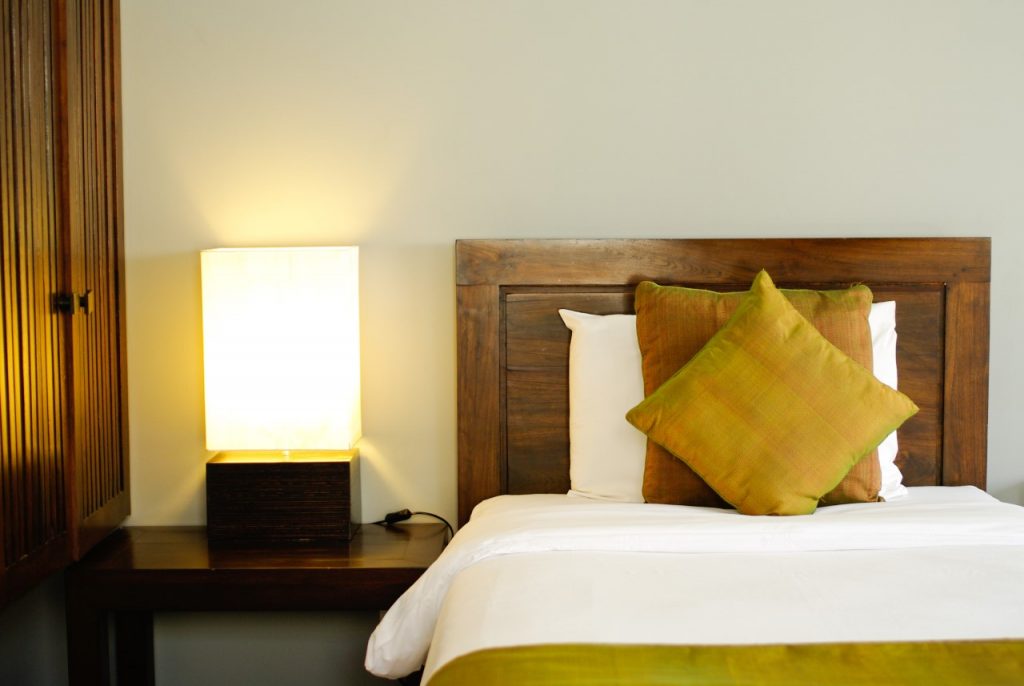
We are reader-supported. When you buy through links on our site, we may earn an affiliate commission.
Lighting is key when it comes to establishing an aesthetic in a room. But what happens when you don’t have sunny windows in your space? Fortunately, even rooms without windows can appear lighter with a few decorating tips in mind. Here are a few pointers to help you learn how to lighten a dark room with no natural light.

1. Make Use of Artificial Light
Hundreds of years ago, a room with no natural light sources may have been doomed to darkness. Fortunately, our easy access to modern-day light sources means that anybody can transform a dull room into a shining space overflowing with light.
Use this as the perfect excuse to head to your local furnishing store to browse different lighting options. If you need more than a few floor or table lamps, consider investigating overhead fixture options, too. The key to successfully establishing a better sense of light in your room is to nail the amount of soft and warm artificial light that’s responsible for lighting your space.
2. Artificial Lighting Ideas for Your Home
Not sure where to get started? Use these topics to pick the light fixtures and temperatures that can lighten a dark room:
Overhead Lighting
Overhead lighting is probably the first element you’ll want to consider when brightening up a space. This is because the downlighting effect from an overhead lamp will wash over the walls and set the mood for the entire room. Therefore, it’s important to strike a balance here; overhead lights should provide warm light without overpowering the room and casting unwanted shadows.
Frosted or soft white light bulbs are perfect for overhead lighting since they don’t create harsh tones. For maximum design impact, pick a striking chandelier or light fixture for your overhead light. Alternatively, keep it toned-done and amp up the style with corner lamps and sconces.
Recessed Lighting
Need something even less obtrusive than overhead lighting? This might be the right pick for you.
Recessed lighting, sometimes known as can lighting, refers to light fixtures that are flush with the ceiling. These lights don’t take up much space, but they can spread light evenly throughout a room. Planning a recessed lighting installation carefully can help a darker room look well-lit and natural without requiring vertical space.
Experts recommend researching the color array of LED recessed lights. White lighting is often preferred to prevent strange reactions with paint colors in the room. You should also look to include a light dimmer, which can help you customize the level of lighting you want throughout the day.
Accent Lighting
Lightening up a dark room doesn’t require uniformity. Think through the functionality of your space. Is your darkest room the dining room, where you’d like a romantic ambience, or a home office, where focused work and quiet reading time takes precedence? The accent lighting you choose will depend on the mood you need to set.
Quiet reading corners should be filled with warm light via a table lamp or striking floor lamp that illuminates the book nook without lighting up the whole room. Bedrooms often need soft light via nightstand lamps or wall sconces that can help you settle into a good night’s sleep. Add dimension to your artificial lighting by picking stylish light fixtures that can be used for unique purposes.

3. Switch Up Your Wall Color
Even after investing in a handful of stylish and bright lamps, your vision for a well-lit room may fall short if you have the wrong color plastered on your walls.
In a room suffering from no natural light, the best way to brighten up your space is to invest in colors that accent the light you’re able to produce artificially. This means that you should always steer clear of dark tones that accentuate your lack of light.
But, that doesn’t mean you’ll be lacking in options. Some of the best paint colors for low-light rooms include lavender, powder blue, soft gray and bright orange — granting you access to the diverse palette you need.
4. Avoid Over-Cluttering Floors
A common issue people experience in their rooms is a lack of space. This problem grows even bigger in rooms without much light, since a cluttered look can make a space appear even darker.
If this an issue you’re grappling with, consider using your wall space for storage instead. When you free up the floor, you make your room look larger and lighter in effect. Plus, you’ll enjoy having a clutter-free space you can enjoy being in, too.
5. Put an Oversized Lamp in the Corner
Corners can easily get lost in a room with lighting issues. Sometimes, even well-lit rooms struggle to bring light into the corners of a space.
A simple decorating tip that’ll help you maximize your appearance of light in any space is to invest in an oversize floor lamp that you can tuck neatly into the corner. When you turn on the lamp, light will pour into your room. Plus, you’ll give a purpose to a corner that is often otherwise dark or barren.

6. Invest in a Mirror (or Many)
Mirrors are already notoriously known for increasing the appearance of a room’s size. Because this is a result of their reflective properties, they’re also great design tools for correcting dark rooms.
If you have a small window that appears to give you little to no light, place a mirror on the opposite side to amplify the amount of light your receive. It’s also helpful to place a mirror on the other side of artificial light sources, too. They’re a great decorating piece that can also help bounce the amount of light you’re receiving around the room — creating the illusion of a more lit space.
7. Lighting With Adjustable Settings Is Key
Natural light varies throughout the day. When you first wake up in the morning, sunlight may pour into your room. When you begin to settle in for dinner, it gently starts to fade away for the evening.
Nailing this variation in light is one common issue homeowners and apartment renters struggle with when experiencing a lack of natural sunlight. You want the ambiance to be just right, but how can you achieve the same effect when relying primarily on artificial light sources?
For many, the answer is to invest in lights with manual dimming settings. In the morning, you can add a brighter touch to your day to mimic the outside world. When you’re preparing for bed, you can also tone down the brightness to avoid overwhelming yourself with too much light before you sleep.
Brightening a Dark Room Without Natural Light
Struggling to figure out how to lighten a dark room with no natural light? When you don’t have any natural sunlight to depend on, it’s time to get creative. Artificial lighting, mirrors and other decorating ideas can illuminate a dim room and make it an enjoyable spot in your home.
As it turns out, balance is key. With a few of these lighting tricks in mind, you’re well on your way to achieving a room that raises your spirits with the lighting that you deserve.
Editor’s note: This post was originally published in August 2019. It has recently been updated and republished.







